
This post may contain affiliate links. We may receive a small commission, at no cost to you, if you make a purchase. Read Disclosure.
Travel is not always about visiting the best beaches, engaging in wild adventures, and downing sunset cocktails. It can also be a journey of learning and diving deep into culture and history.
If you want to learn about American history, then the best place to do that is along the East Coast. It’s where British explorers first landed on the shores of North Carolina in 1606, and where major events in The American Revolutionary War (April 19, 1775 – September 3, 1783) took place.
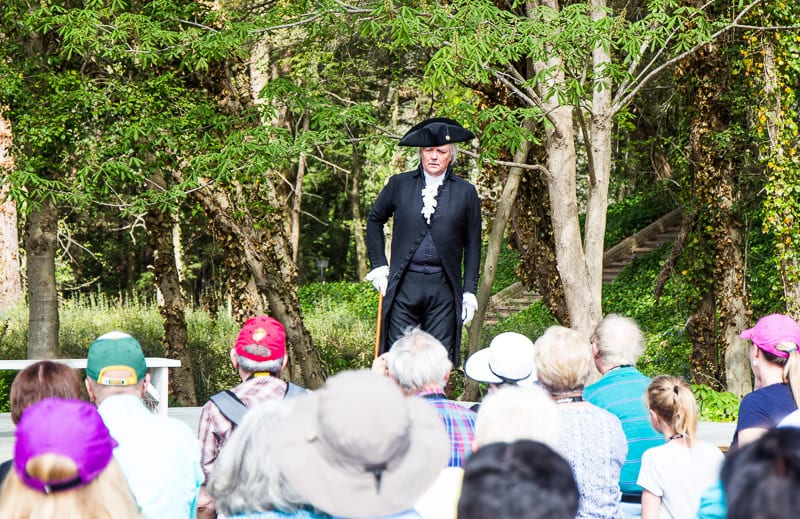 George Washington colonial-williamsburg-virginia (21)
George Washington colonial-williamsburg-virginia (21)
If you’re planning a Revolutionary War Road Trip along the East Coast, and not sure what sites to visit, then below is our complete itinerary for a Revolutionary War road trip.
Our family enjoyed this road trip, which took us 3 weeks to complete. We loved learning about what makes up the spirit of Americans and visiting the places and experiences that tell the story of the Revolutionary War.
Ditch the text books, jump in the car and head to the areas along the east coast were the story was born.
Map of this Revolutionary War Road Trip Itinerary
To help you plan your own road trip of these Revolutionary War sites, here is an interactive map of the attractions and places mentioned in this guide.
Charleston, South Carolina
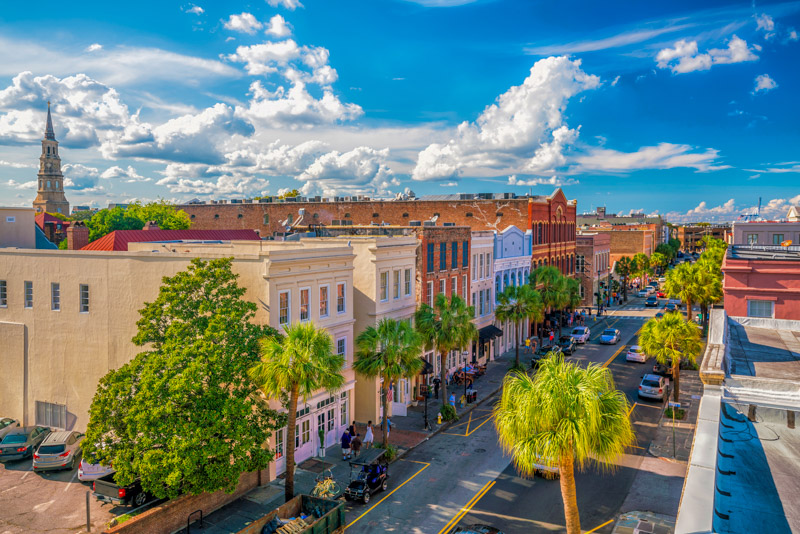
This road trip begins in Charleston in South Carolina, a quaint city known for being a major site of conflict during the war for independence.
It’s home to Fort Sumter, where the first shots of the Civil War were fired.
Here, the Patriots fought hard to defend Charleston from British soldiers, culminating in the Siege of Charleston in 1780, one of the most significant defeats for the Continental Army.
You can tour the Old Exchange and Provost Dungeon, where British Army officers once held prisoners and where the Stamp Act was famously protested in 1765, a pivotal moment leading up to the Revolution.
One of the most important historical sites is the Charles Towne Landing State Historic Site, where the first permanent English settlement in the Carolinas was established in 1670.
Camden Battlefield and Longleaf Pine Preserve, SC
Distance: 2 hrs 30 mins | 134 miles
After visiting Charleston, drive north to Camden Battlefield and Longleaf Pine Preserve, known for being the grounds of The Battle of Camden, fought on August 16, 1780.
It was one of the most significant and disastrous defeats for the Continental Army in the war.
The site is now a preserved battlefield where visitors can explore the area and learn about the pivotal clash between American forces, led by General Horatio Gates, and the British forces under Lord Cornwallis.
The American defeat at Camden set the stage for a shift in leadership within the Continental Army and marked a low point in the war for the Patriots.
If you’re long on time and curiosity, you may want to detour two hours west to the Ninety-Six National Historic Site, which is part of the Southern Campaign of the American Revolution Parks in South Carolina. The site offers a glimpse into the Revolutionary War history of the region, with well-preserved fortification, the site of the original Ninety-Six Village, and educational exhibits in the museum. Savannah and I visited on a road trip through the Old 96 District and enjoyed walking the loop trail through the site.
Cowpens National Battlefield, SC
 Distance: 2 hours 14 mins | 108 miles
Distance: 2 hours 14 mins | 108 miles
Another battlefield in South Carolina to visit is Cowpens National Battlefield, where the Battle of Cowpens was fought on January 17, 1781.
It marked a crucial turning point in the Southern Campaign, as the Continental Army, led by Brigadier General Daniel Morgan, decisively defeated the British forces under Lieutenant Colonel Banastre Tarleton.
This was one of the great American victories that greatly weakened the British hold on the South and set the stage for the eventual American triumph.
You can explore the well-preserved battlefield, where interactive exhibits and walking trails provide a detailed account of the battle’s tactics, and visit the park’s visitor center to read informative displays and marvel at exhibits about the battle, its leaders, and the strategic importance of the victory.
Kings Mountain National Military Park, SC
Distance: 36 mins | 30.2 miles
Just a short drive away is Kings Mountain National Military Park, where the Battle of Kings Mountain was fought on October 7, 1780.
The battle is famous because it took place on a rugged, wooded mountain, where a group of over 1,000 American frontiersmen, led by figures like Colonel William Campbell, decisively defeated a force of 1,100 Loyalists under Major Patrick Ferguson.
This victory was the first major victory following a series of defeats.
Walk the well-preserved battlefield, where a 1.5-mile trail takes you up the mountain to key sites related to the battle, and learn more about the events at the Visitors Center.
Greater Williamsburg, Virginia
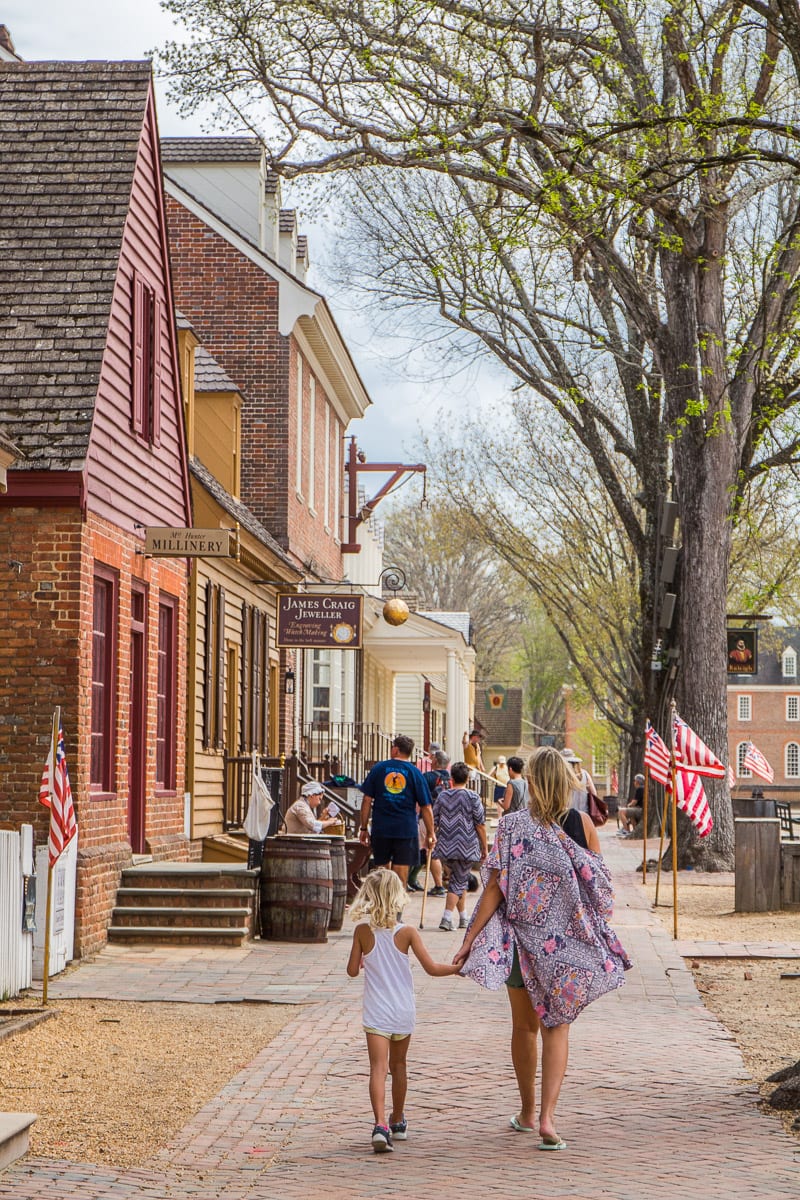 Strolling Colonial Williamsburg Distance: 5 hrs 34 mins | 374 miles
Strolling Colonial Williamsburg Distance: 5 hrs 34 mins | 374 miles
Visiting Greater Williamsburg in Virginia gave me a fascinating insight into the birth of the United States, a greater understanding of the American culture, and strangely enough, a better understanding of my own culture.
It’s the perfect starting point for your Revolutionary War Road Trip and will give you a deeper insight into life before the War of Independence, which lead to the unrest and the resulting cause.
For a comprehensive history lesson on America’s Enduring Story, I recommend spending a day at each of the following:
Jamestown Settlement and Historic Jamestowne
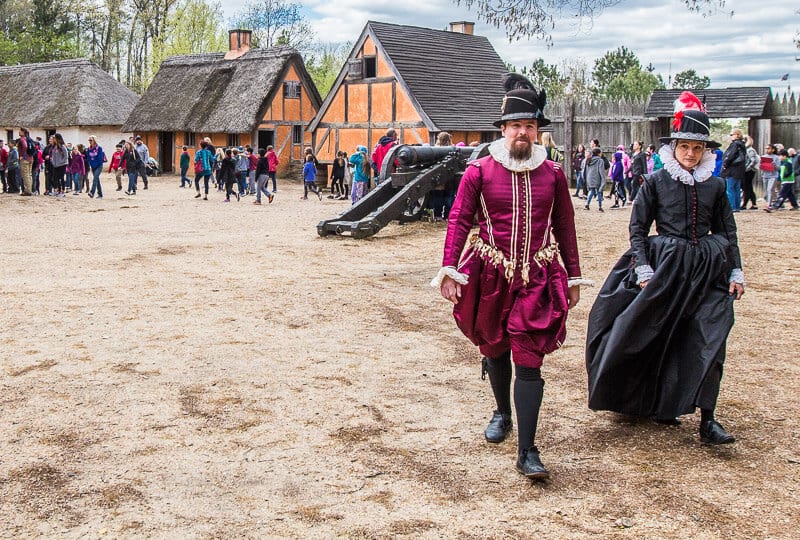 Jamestown Settlement
Jamestown Settlement
Jamestown Settlement is a living history museum that tells that story of the English colonist establishing a permanent English colony (and their many almost failures).
Learn about the first settlement and Powhatan and her people’s struggle to accept the foreign invaders.
Historic Jamestowne is the original site of the 1607 Fort and the place where legendary figures John Smith, Pocahontas, John Rolfe and more walked and helped write the beginnings of the USA.
Colonial Williamsburg
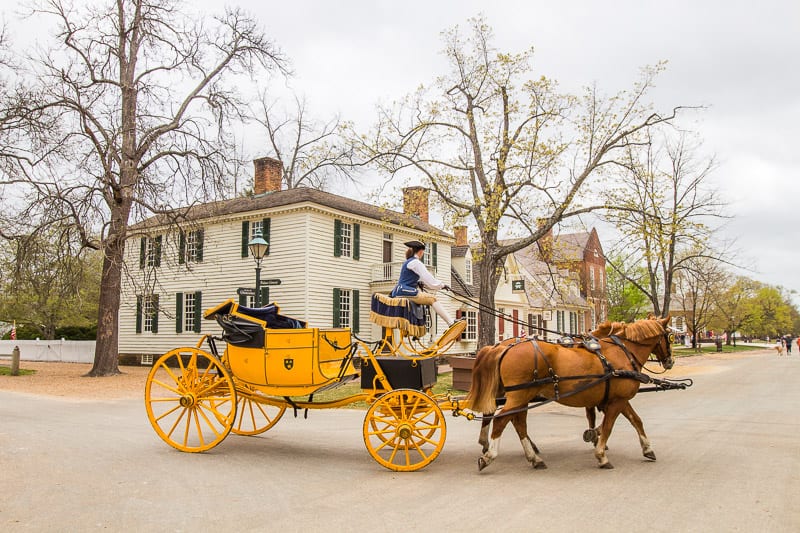 A revolutionary road trip easy coast usa
A revolutionary road trip easy coast usa
Colonial Williamsburg is where the ideals founding the Constitution began to grow. It’s 18th Century Colonial Virginia brought back to life with live reenactments, noon day cannons, Patriots at Play games and inspiring speeches by George Washington.
The re-enactments and characters roaming the streets give you a profound sense of the evolving American story and help kids understand the ideas and values that crafted the world they live in today.
There are over 35 historical sites and 22 trade sites in Colonial Williamsburg, including the Capitol, where the people’s representatives voted for Independence; the opulent Governor’s Palace; and working trade shops including the apothecary, the shoemaker and more.
Yorktown Battlefield and American Revolution Museum at Yorktown
 Yorktown battlefield
Yorktown battlefield
The Yorktown experience is where those hard-fought ideals became reality.
Here, you can walk the Yorktown battlegrounds where the Americans defeated the British, which ultimately led to America’s Independence.
The interactive American Revolution Museum at Yorktown tells the story of the nation’s founding from the twilight of the Colonial period to the dawn of the Constitution. It helps you further understand complicated documents like the Constitution and how it’s relevant to our current lives.
This fascinating learning experience was probably the highlight of my trip to the Greater Williamsburg area.
Monticello, Virginia
 Distance: 1 hr 52 mins | 123 miles
Distance: 1 hr 52 mins | 123 miles
Monticello is a place to go to get a glimpse into the life of Thomas Jefferson, the third President of the United States and the author of the Declaration of Independence.
Nestled atop a hill sits Jefferson’s architectural masterpiece, a home designed by him and reflecting his Enlightenment ideals.
The estate, which is now a UNESCO World Heritage site, allows guests to explore the mansion which features Jefferson’s study, personal belongings, and designs he created.
You can also learn about Jefferson’s complex legacy—his role in shaping the nation’s early democratic ideals alongside his ownership of enslaved people, including those who lived and worked at Monticello.
Washington D.C.
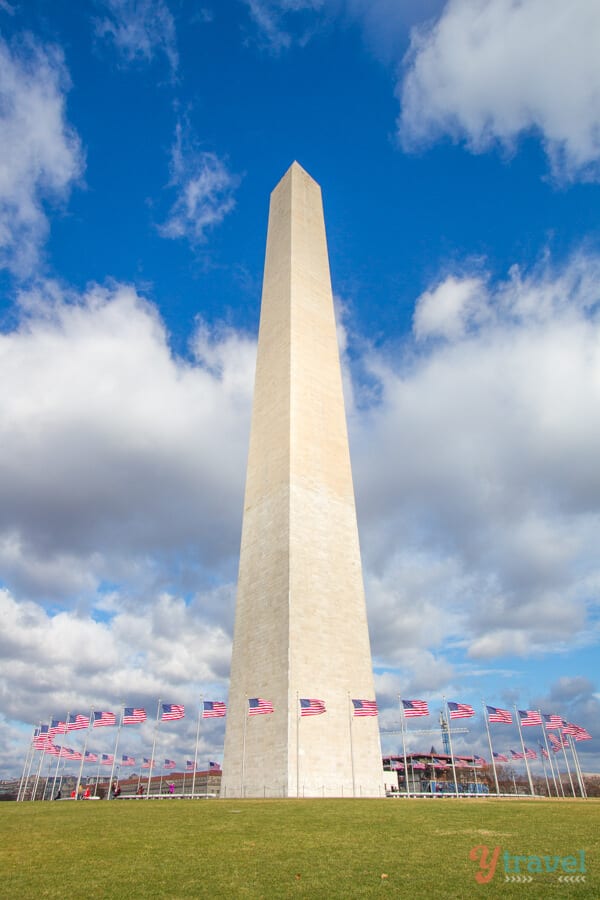 Washington Monument, DC Distance: 2 hrs 39 mins | 124 miles
Washington Monument, DC Distance: 2 hrs 39 mins | 124 miles
Although Washington, D.C. did not become the center of American government until 1790, the U.S. capitol is home to various monuments and artifacts of Revolutionary War history, including the Washington Monument and the Declaration of Independence.
You can learn more about the government created because of the Revolutionary War at the Capitol Building and White House.
Nearby is Mount Vernon, the home of George and Martha Washington, one of the heroes of the Revolutionary Tale.
You can to see where the former general and first President of the United States lived.
The Washington D.C. Sightseeing Pass can save you money on tours and attractions in D.C. Learn more here.
Gettysburg, Pennsylvania
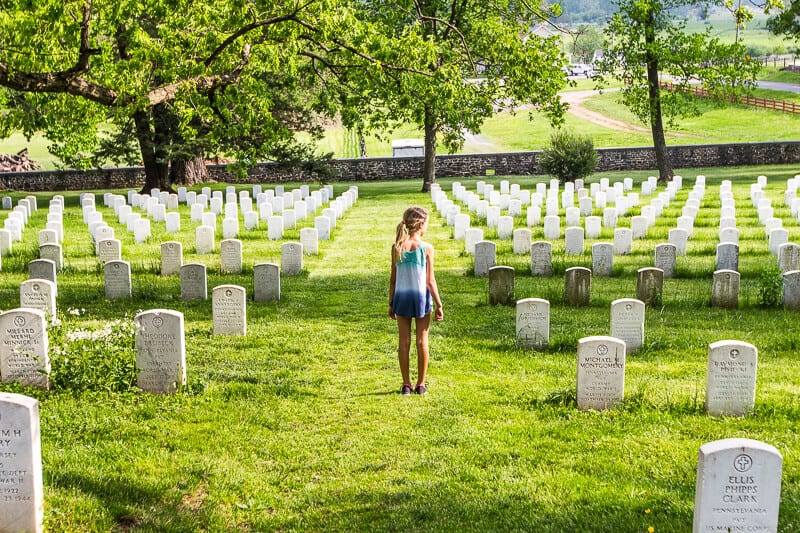 Gettysburg National Cemetery Distance: 1 hrs 58 mins | 82 miles
Gettysburg National Cemetery Distance: 1 hrs 58 mins | 82 miles
One thing I love about planning a road trip around a theme, is you can utlize the time and route to add in other exciting experiences or places that may not fit the theme but pass on through it.
Consider taking a detour over to learn about the Civil War history at Gettysburg, which is only 2 hours from DC.
It’s a hauntingly spiritual place that tells the story of this great battle and turning point in the Civil War.

The town is best known for the Battle of Gettysburg, fought from July 1-3, 1863, which became a turning point in the war.
While the battlefield itself is located in Pennsylvania, the impact of the battle was felt throughout the entire region.
Explore Gettysburg National Military Park, which encompasses a museum, a visitor’s center, and a battleground.
Learn about the strategies, key figures like General Robert E. Lee, General George G. Meade, and President Abraham Lincoln, and the impact of the war on soldiers and civilians alike.
See the site of the famous Gettysburg Address, delivered by Lincoln in November 1863, and walk through the hallowed grounds where there were more than 50,000 Confederate and Union casualties.
Philadelphia, Pennsylvania
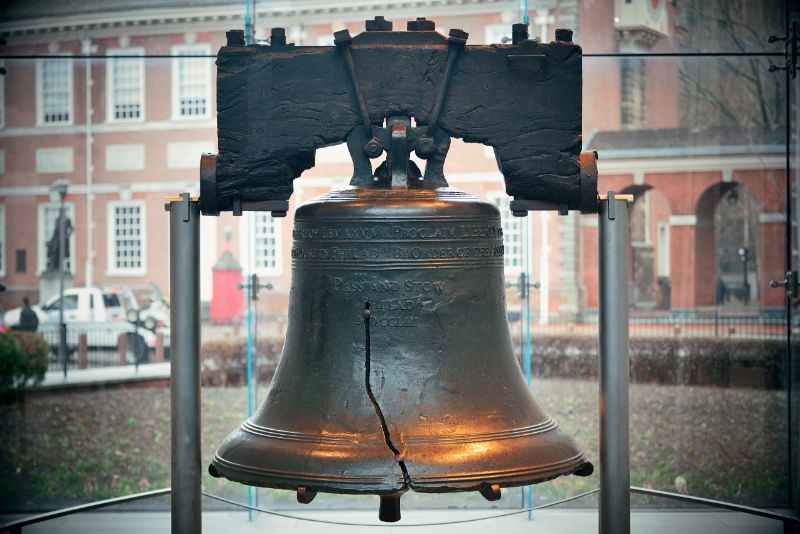 The Liberty Bell Distance: 2hrs 37 mins | 140 miles
The Liberty Bell Distance: 2hrs 37 mins | 140 miles
Philadelphia in Pennsylvania is an important stop on the Revolutionary road trip as its where the United States Constitution was written and Declaration of Independence was signed in the Independence Hall.
Philadelphia was the headquarters, if not the official capital, of the colonies during the American Revolutionary War. Philadelphia’s Historic District, the birthplace of the nation and the first World Heritage City in the U.S.
There are many historical sites in Philadelphia that tells the story of the war including The Betsy Ross House, Carpenter’s Hall, Declaration House and Museum of the American Revolution.
You can tour the Constitution Center, see the Liberty Bell, the famous symbol of freedom for the United States during the Revolutionary War and visit the site of Ben Franklin’s home and offices.
About 40 minutes north west of Philadelphia is Valley Forge Historic Park, the site of the third winter encampment of the Continental Army during the American Revolutionary War between December 19, 1777 to June 19, 1778.
Here you’ll find Washington’s Headquarters, a stone house on the Schuylkill River, which was occupied by George Washington.
The park contains historical buildings, recreated encampment structures, memorials, museums, and recreation facilities. It also has 26 miles (42 km) of hiking and biking trails.
The Philadelphia Sightseeing Pass can save you money on tours and attractions in Philadelphia. Learn more here.
Boston, Massachusetts
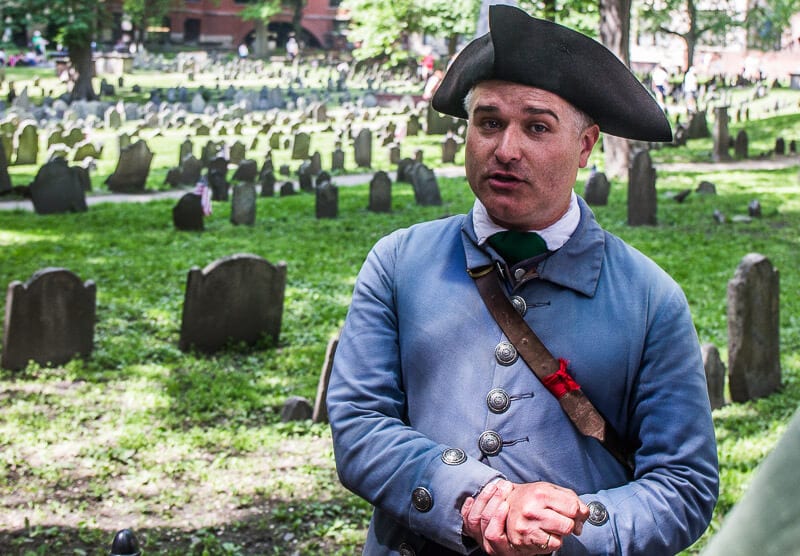 The Boston Freedom Trail – so much fun Distance: 5 hrs 20 mins | 306 miles
The Boston Freedom Trail – so much fun Distance: 5 hrs 20 mins | 306 miles
Boston, Massachusetts is one of our favorite cities in the US for its European feel and robust sporting culture. It’s full of historical experiences, especially related to the American Revolutionary War.
Boston and the surrounding areas were the settings for various important events including the Boston Massacre, the Boston Tea Party, and the Battle of Bunker Hill. You can also visit Paul Revere’s House and the Old North Church, both important Revolutionary landmarks.
One of our favorite tours in the USA (so far) is the guided Freedom trail walking tour. We learned a lot about the Founding Fathers, the Revolutionary War and Independence through historic events and tales, many hilariously told.
Boston is a city of so many firsts, so be sure to read our post below to discover how you can experience them! While in town, why not enjoy a Boston Red Sox game at Fenway Park, tour Harvard University eat at America’s oldest restaurant, the Union Oyster House.
Lexington Battle Green
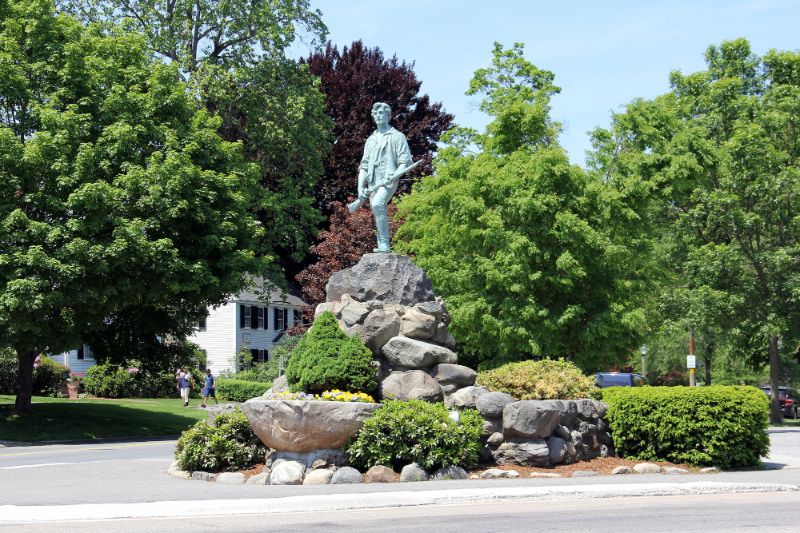 Monument at Lexington Battle Green
Monument at Lexington Battle Green
About 40 minutes north west of Boston is the Lexington Battle Green, properly known as Lexington Common, is the historic town common of Lexington, Massachusetts where the opening shots of the Battles of Lexington and Concord were fired on April 19, 1775
These were the shots that started the American Revolutionary War. Now a public park, the common is a National Historic Landmark.
West Point & Saratoga
 West Point Military Academy
West Point Military Academy
West Point is on the way between Boston and New York, so if traveling through here in either direction it may well be worth putting it on your list.
West Point is now home to the United States Military Academy.
In 1781, George Washington called this area “the most important Post in America,” during the Revolutionary War. Holding West Point meant preventing the British from controlling the Hudson River and dividing the colonies in two.
It’s also the place of Benedict Arnold’s act of treason. The traitor agreed to help the British capture West Point. His plot included capturing Washington while he dined with Arnold at West Point
To add in more Revolutionary experiences and a 2 hour detour to your route between Boston and New York City is Saratoga.
Why this is a valuable road trip?
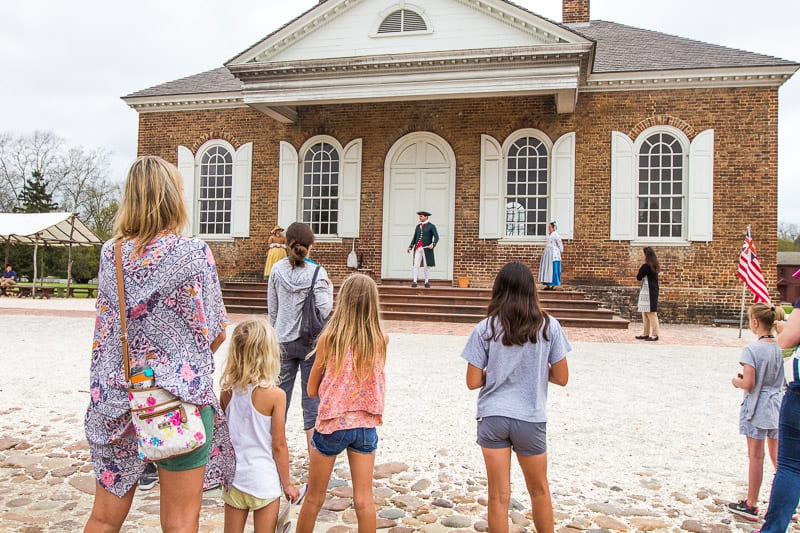 Colonial Williamsburg
Colonial Williamsburg
History is the story that has helped create who we are, what we believe in, and shows us what we are capable of. It (hopefully) inspires us to follow in the footsteps of those before us who created greatness, or, warns us to turn back from the path that creates the opposite.
One of the most inspiring stories from America’s history is their fight (and victory) for independence from Britain – something my own country is yet to do.
Before traveling this Revolutionary War road trip in the east, I never could quite comprehend America’s rhetoric over “freedom and liberty” and fascination with war, and seemingly over-the-top patriotism.
Because of this trip, I understood these statements are not necessarily made in ignorance of other countries, but in celebration of how they arrived.
They believe in freedom for all as it’s what drove them to create the life they have now, which is why they are at the forefront of fighting for others to have it (most of the time – everything is mostly!)
We all travel with our own way of looking at the world. Many things we encounter will seem strange and we may be judgmental or overly critical of them.
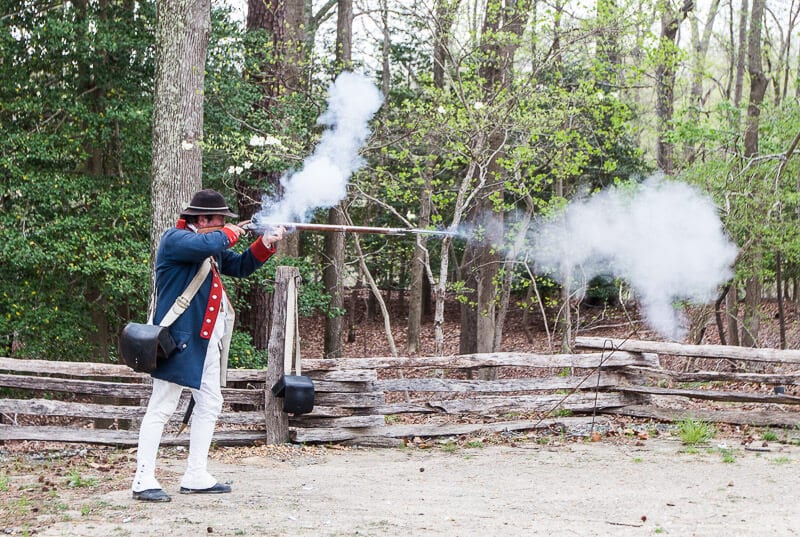 American Revolution fighters
American Revolution fighters
Once we learn the stories and why they are so important, we can better understand. Our perspective changes and we can connect more deeply to the culture.
It’s also only when we step outside of ourselves (or our own culture) that we can look back and understand ourselves better. (Read more here)
We included this in our best road trips in the USA list.
Comment: We’d love to hear your tips on exploring the Revolutionary War history on an East Coast USA road trip? Did we miss any stellar experiences? Are there other places nearby you’d recommend? Share below.
Please visit:
Our Sponsor
